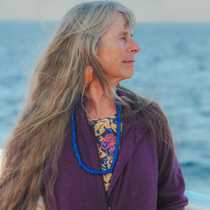Early this morning the Sea Lion began her passage through a series of narrows that cut through part of the western side of Baranof Island. At 6:26 AM we were moving south through Sergius Narrows. As the light filtered through clouds coming in off the Pacific Ocean many of us remained on the bow searching for the morning inhabitants of Baranof Island! From Sergius Narrows we continued south into Neva Strait as the Sea Lion positioned to drop her hook near Halleck Island for some early morning exploring. Zodiacs were lowered and we were all called to the aft section of the vessel in preparation for a visit ashore. The Natural history staff had explored the beach landing and found a well-used bear trail that would lead us into the forest.
Once everyone was ashore we divided into two groups and began a relaxed walk into the Southeast Alaska temperate rainforest. All around us the emerging plants of spring gave clues to the mild winter that had just passed in this part of Alaska. Beach rye grass pushed its way up through the dead grass of last year. We found several well-used burrows where small animals nested, a front door facing the beach, and a well used path leading out into the small rodent world. Near the edge of the woods and just inside we found many Eagle feathers decorating the forest floor, pointing to perches over-head, where these large birds of prey molted during the previous fall.
We explored the forest edge just inside its protection from the beach. A cold wind blew over the water and surrounding islands, but inside the tree line we were protected and had a chance to do a little poking about to observe many of the different levels or canopies that make up a rain forest of the north.
To add to our closer look at this unique environment, we all had an opportunity to explore the coastline of Halleck Island by Zodiac. Three boats were brought ashore, and our naturalists headed out into the stiff breeze to see what surprises might present themselves! We saw many Bald eagles, a Martin and a River otter all taking care of the business of making a living in a northern forest. All too soon we were called back to the Sea Lion for lunch and to continue cruising towards our afternoon destination of Sitka.
Arrival in Sitka was at approximately 1:15 PM. Once the gangway was in place we made our way towards a blue and white school bus and began our tour of this well-known Alaskan town. “Sitka” is taken from the Tlingit peoples word “Shee-Atika” (people who live near the sea). Sitka is extremely old, and the earliest cultural dating goes back to the eruption of Mt. Edgecombe some 8,000 years ago. This blast covered the Sitka Sound and surrounding coastline with as much as twenty feet of ash. As the land recovered and the Ice sheet continued to retreat, the Tlingit people gradually moved into the area, settling Sitka Sound.
In 1804 the Russian Empire forced its way into Sitka, and remained there until the sale of Alaska in 1867. This small town was the seat of the territorial government until 1906, when Sitka yielded that responsibility to Juneau.
Today, the 9,000 inhabitants take pride in having remained a small community. The town’s people are friendly and much of the Russian and Tlingit history is accessible to the tourists who have come to this northwestern island location to see the beauty and learn a little about its early history.
Just as the ancestors so many thousands of years ago, we could see the same wild vistas of mountains and ocean; the salmon rivers, the whales and sea lions offshore, the Eagles and Ravens calling out in wonderfully strange songs from the forests. The descendants of the new settlers and the descendants of the same ancestors still live in this ancient village sight, carry their clan affiliations into celebration and carve totem poles in dedication to a culture that has not been lost, but has evolved moving towards the future.




